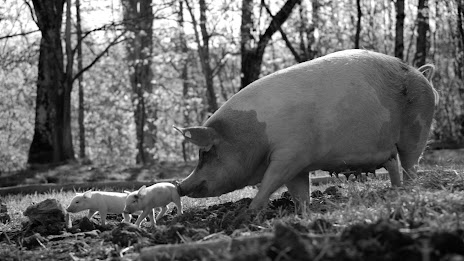By José Alberto Hermosillo
“Gunda” is a fascinating and minimalist depiction of the tranquil life in a farmhouse, where pigs, chickens, and cows take center stage. “Gunda” is one of the best documentaries of the year!
 |
| Gunda director Victor Kosakovskiy. Photo: José Alberto Hermosillo, Festival in LA ©2020 |
Victor Kosakovskiy (“Aquarela,” ¡Vivan las Antipodas!”) is an accomplished Russian documentarian.
In “Gunda,” he takes us into an observational passage with stunning cinematography, perfect use of a nonintrusive camera, and crystal-clear sound. The film is captivating audiences and has received awards—at the Berlin and Stockholm film festivals—for being nominated for Best Documentary at the European Film Awards and an IDA Award. Many may find the pace gridlocked yet compelling and thought-provoking.
 |
| Gunda, executive producer Joaquin Phoenix. Photo: José Alberto Hermosillo, Festival in LA ©2020 |
Joaquin Phoenix, an animal rights activist, serves as the film's executive producer. As he did in his acceptance speech at the Oscars 2020, when he won Best Actor for “Joker,” his advocacy pleads for love and compassion for other species and how we can balance the food chain intelligently and humanely.
The documentary
raises awareness about how domestic animals show emotions through behavior. We see a mamma pig caring for her piglets, caged chickens experiencing freedom
for the first time, and cows running without restrictions on the fields.
 |
| “Gunda.” Photo courtesy of NEON. |
The film opens with a steady shot of the exterior of a barn. Inside, a mother pig is giving birth to about a dozen piglets. It is a miracle of life. As every little pig comes to the exterior, we fall in love with them. They are adorable! – it is also what the protective mother pig thinks. The day passes, and the entire pack goes out for a stroll to discover the delights of the dirt in their vast universe.
When a flock of
caged chickens slowly and cautiously moves out, the physical damage suffered for an entire life in captivity is noticeable. One chicken is
without a leg, and others miss many feathers, all
disoriented.
The fascinating trend continues with a gorgeous display of big, healthy cows interacting and
running freely in the open. Those images make us think about all sorts of things, such
as how valuable life is for everybody in the field, even those domestic creatures we cage, kill, and consume in our daily diet.
When Kosakovskiy decided to make a white silent film, he wanted the
audience to experience, in first person, a glimpse of life on a farm. He knew he
needed to spend months with the best equipment possible—the best camera and
sound, no music sugar-coating, and plenty of inspiring
images of nature.
For years, Kosakovskiy needed help raising the budget to make this film, and pitching a black-and-white trinity movie with pigs, chickens, and cows as the main stars was hard. To convince producers to invest in his project, he referred to other similar successful films like “Ida,” “Cold War,” and “Roma.” Now, he is glad the producers could see his vision and the intention to shoot a naturalistic film.
 |
| “Gunda.” Photo courtesy of NEON. |
The small camera crew worked tirelessly from noon until sunset to capture the animals’ actions and reactions. Those long working hours were nothing compared with the precious moments they captured, which dramatically enhanced the story.
Kosakovskiy’s experience working in cinema made him make the right decisions, using long lenses not to distract the animals. For that, he needed the best steady cam operator to keep the proper distance between the camera and the subject, avoid being invasive with the animals, or alter the natural outcome. To photograph the living beings from far away was not an esthetic choice but a moral one.
In a movie set, the director is always in control of every given situation. In this documentary, the director had to be patient and not dictate something he couldn’t control, such as animal behavior, weather, and human challenges. To make “Gunda,” the filmmakers traveled to animal sanctuaries in Norway, Spain, and the United Kingdom.
 |
| Hollywood Legion Theater Photo: José Alberto Hermosillo, Festival in LA ©2020 |
Kosakovskiy said after a drive-in screening at the Hollywood Legion Theater, “Making this movie changed the way I see life.” The whole intention was to show life on a farm without saying anything and understand what a mother pig feels: seriousness, sadness, and hopelessness.
 |
| “Gunda.” Photo courtesy of NEON. |
He continued the conversation. “All those creatures have a soul, and discovering those emotions is moving. The pig compellingly talked to us. In the very last scene, the pig’s behavior looks scripted. It was a
miracle; the team cried.”
The film helps us determine the similarities between animal and human behavior.
After admiring such a marvelous work of art, I decided to eliminate “Lechón Asado” from my Cuban diet. I am not Cuban; I am just a lover of the world’s cuisine. I am also becoming more appreciative of my Mesoamerican culture, which is based on vegetables and insects.
As an agent of
change, I will continue loving eating my greens, as much as this documentary
made me care for the voiceless creatures of every farm in the world
because sustainable farming is possible.
“Barry” And “The Wonder Years” Of Barack Obama
And Then We Danced: Folk, Love & Pride in Georgia
IF YOU ARE READING FROM A MOBILE DEVICE, CLICK: view web version FOR OTHER COOL FEATURES SUCH AS TRANSLATE POWERED BY GOOGLE, AN INTERACTIVE FILM FESTIVAL CALENDAR, AND MORE.

